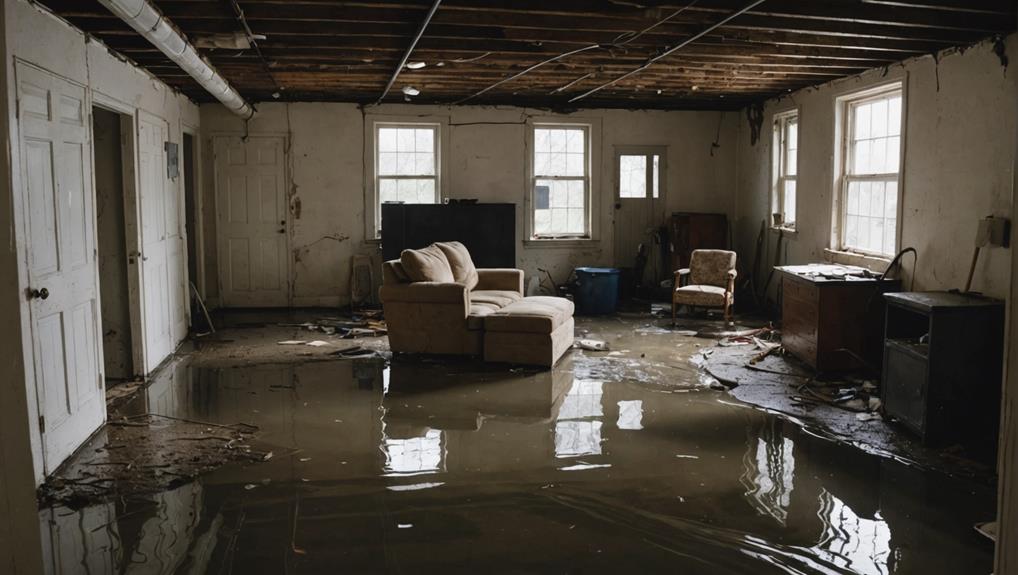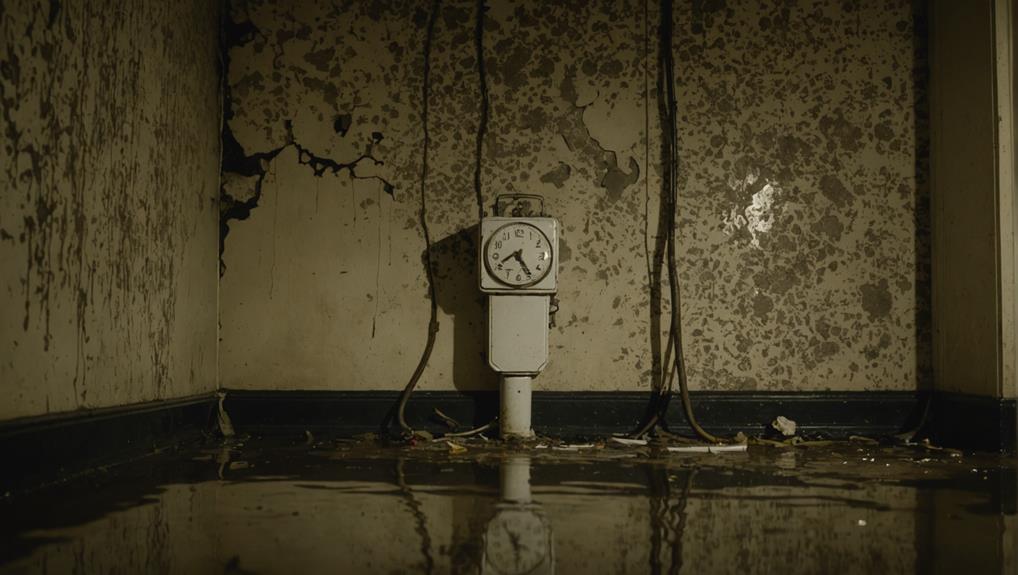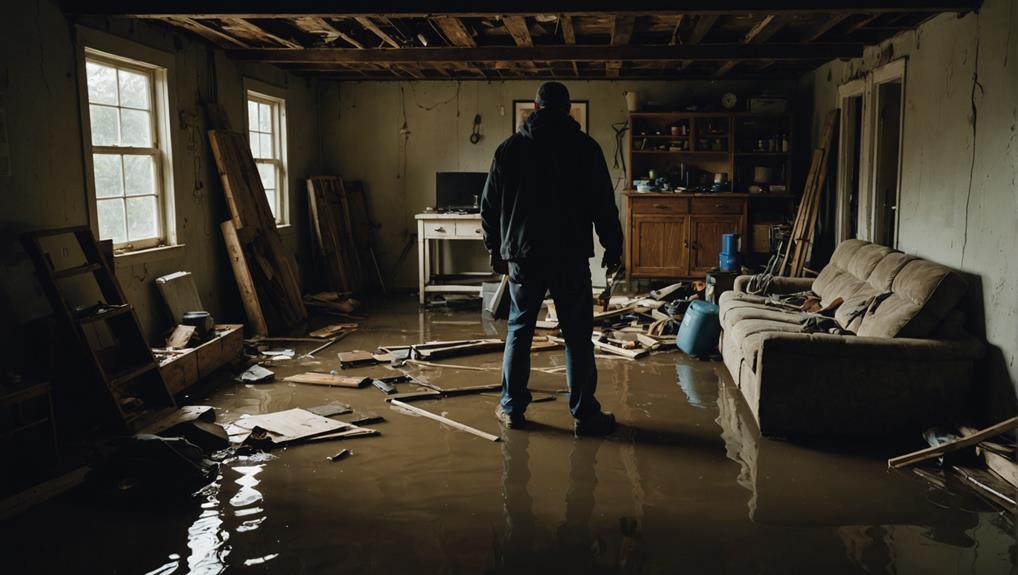Water damage can turn your home into a horror story, especially if you ignore early signs or delay repairs. Small leaks can escalate quickly, leading to structural damage and costly mold issues. Tackling repairs yourself often backfires, creating more problems than solutions. Choosing the wrong contractor can add to the chaos; always check qualifications and reviews before hiring. Finally, don't neglect your insurance coverage. Many policies exclude certain types of water damage, leaving you vulnerable. Awareness of these pitfalls is your first step in prevention, and there's more you can do to protect your home effectively.
Common Causes of Water Damage

When it comes to water damage, understanding the common causes can save you a lot of headaches down the line. One major culprit you should be aware of is frozen pipes. When temperatures drop, pipes can easily burst, leading to significant leaks. Appliance leaks are another common issue; your washing machine or dishwasher could spring a leak without warning.
Roof leaks often go unnoticed until they cause serious damage, so regular inspections are key. Don't forget about sump pump failures, which can leave your basement vulnerable during heavy rain.
Drainage issues around your home can likewise lead to water pooling, creating a perfect environment for foundation cracks to develop. And let's not overlook plumbing failures—old or faulty pipes can burst unexpectedly, leaving you with a mess to clean up.
Lastly, weather events, like heavy snow or intense storms, can overwhelm your home's defenses. By keeping an eye on these common causes, you'll be better equipped to protect your space and avoid costly repairs. So, take a proactive approach to safeguarding your home against water damage!
Ignoring Early Signs
Ignoring early signs of water damage can lead to monumental problems down the road. You might notice a small water leak or perhaps a stain on your ceiling that seems harmless. But let me tell you, these seemingly minor issues can escalate quickly if not addressed. Water leaks don't just disappear; they can seep into walls and foundations, causing structural damage and mold growth that's a nightmare to deal with.
Moisture detection is key to catching these problems early. If you feel a dampness in the air or spot discoloration in your walls, take action. It's crucial to investigate and determine the source of the moisture before it spirals out of control. Trust your instincts—if something feels off, it probably is.
Delaying Repairs

When you put off necessary repairs after water damage, you're opening the door to escalating repair costs that can quickly spiral out of control. Not only does this delay jeopardize the structural integrity of your home, but it furthermore creates a perfect environment for mold growth, which can pose serious health risks. Addressing the issue promptly is essential to safeguarding both your property and your peace of mind.
Escalating Repair Costs
Delaying repairs after water damage can lead to skyrocketing costs that strain your budget. When you put off fixing leaks or addressing mold issues, you're not just risking your home's safety; you're inviting a cascade of financial burdens. A simple cost analysis shows that the longer you wait, the more extensive the damage becomes. What starts as a minor repair can quickly escalate into a major renovation if mold sets in or structural issues arise.
Effective repair budgeting is essential. If you tackle repairs promptly, you can often manage costs and keep them within your budget. Nonetheless, each day you delay adds potential expenses for things like mold remediation or replacing flooring and drywall. You might think, "I'll save money by waiting," but in reality, you're likely setting yourself up for a much larger bill down the road.
Structural Integrity Risks
A home is more than just a place to live; it's an investment in your future, and neglecting water damage can seriously compromise its structural integrity. When you delay repairs, you're not only risking the beauty of your space but additionally the foundation stability that keeps your home standing strong. Water can seep into walls and floors, weakening the materials and leading to costly structural damage down the line.
It's essential to act quickly. Schedule safety inspections as soon as you notice signs of water damage. These professionals can assess the extent of the problem and recommend necessary repairs. Ignoring these issues can escalate into significant hazards, impacting your family's safety and well-being.
Mold Growth Concerns
Ignoring water damage doesn't just threaten the structural integrity of your home; it similarly creates a breeding ground for mold. Delaying repairs can lead to extensive mold growth, which can be a nightmare to deal with. Mold not only damages your property but furthermore poses serious health risks to you and your loved ones.
To help you understand the implications of mold, here's a quick overview:
| Mold Impact | Consequences |
|---|---|
| Health Problems | Respiratory issues, allergies |
| Property Damage | Structural harm, costly repairs |
| Increased Remediation Costs | Higher expenses for mold remediation |
You might think that putting off repairs is harmless, but it's not. Effective prevention strategies are essential. Act quickly to address water damage and consider professional mold remediation if you suspect growth. Keeping your home dry and well-ventilated can help mitigate these risks. Don't wait until it's too late; take action today to protect your home and your health.
DIY Disasters
When tackling water damage repairs, many homeowners underestimate the complexities involved, leading to DIY disasters. You might think you can handle it yourself, but plumbing pitfalls and drainage dilemmas can quickly turn a simple fix into a nightmare. A small leak can easily escalate if you misdiagnose the problem or overlook hidden damage.
For example, you might decide to replace a section of pipe without realizing it connects to a larger plumbing system. One wrong cut could cause significant flooding, leaving you with more damage than you started with. Similarly, if you attempt to address drainage issues without understanding the root cause, you could end up with water pooling in unwanted places, leading to mold growth and structural damage.
It's tempting to save money by taking matters into your own hands, but remember: the risks often outweigh the rewards. Instead of diving into DIY repairs, consider consulting with a professional who can navigate the intricacies of water damage. This way, you can avoid the heartache of a costly mistake and guarantee your home stays safe and dry. After all, your peace of mind is worth it!
Choosing the Wrong Contractor

Choosing the wrong contractor can lead to a cascade of problems that amplify the stress of dealing with water damage. It's easy to feel overwhelmed when your home's at stake, but rushing the process can cost you more in the long run. Start by checking contractor qualifications carefully. Are they licensed, insured, and experienced in water damage restoration? These credentials aren't just formalities; they can make a significant difference in the quality of work you receive.
Don't skip the crucial step of reading contractor reviews. Past clients often share insights that can help you gauge reliability and workmanship. Look for contractors with consistent positive feedback, but be wary of those with a mix of reviews—this could indicate a lack of consistency in their services.
Engaging with potential contractors is important. Ask questions about their approach to water damage restoration, and listen to how they communicate. A good contractor should be transparent and willing to explain the process clearly. By taking the time to choose wisely, you're not just avoiding headaches; you're safeguarding your home and peace of mind. Remember, the right choice can save you money and stress down the line.
Neglecting Insurance Coverage
When it comes to water damage, understanding your insurance coverage is essential. Many people overlook policy limitations and common exclusions that could leave them in a tough spot when disaster strikes. Regularly updating your policy can make all the difference, ensuring you're protected when you need it most.
Understanding Policy Limitations
Although many homeowners believe their insurance will cover any water damage they encounter, a closer look at policy limitations reveals a different story. It's essential to understand the policy nuances that can make or break your coverage. For instance, not all water damage is treated similarly. Some policies might cover sudden leaks but exclude damage from long-term drainage issues.
If you face a water-related disaster, the claims process can be intimidating. You might think you're fully protected, but if your policy has specific exclusions or limits, you could be left in a financial bind. Many homeowners realize too late that their expectations don't match the reality of their coverage.
To avoid costly mistakes, take time to read your policy thoroughly. Speak to your insurance agent about what's covered and what's not—don't hesitate to ask questions. It's better to be proactive today than to deal with a nightmare later. By grasping these limitations, you'll be well-prepared and can navigate the complexities of water damage with confidence. Remember, knowledge is your best defense against unpleasant surprises.
Common Exclusions Explained
While it's easy to assume that your homeowner's insurance will cover all types of water damage, many exclusions can leave you vulnerable. Understanding these policy exclusions is essential, as neglecting them could lead to significant coverage gaps when you need help the most.
Here's a quick look at some common exclusions:
| Exclusion Type | Explanation |
|---|---|
| Flood Damage | Standard policies often don't cover flooding. |
| Negligence | Damage from lack of maintenance isn't covered. |
| Sewer Backup | Backup from sewers is usually excluded. |
Being aware of these gaps helps you make knowledgeable choices about additional coverage. You might want to think about flood insurance or a sewer backup rider, depending on your risk factors. Having these safeguards in place can save you from heartache and financial strain when disaster strikes. Don't let ignorance of your policy exclusions catch you off guard; take the time to understand your coverage. You owe it to yourself and your home to be proactive and prepared.
Importance of Regular Updates
Regularly updating your insurance coverage is crucial to ensuring you're adequately protected against unforeseen water damage. Life changes, whether it's a new roof, a finished basement, or even just an increase in your home's value, can all impact your coverage needs. If you neglect to update your policy, you might find yourself underinsured when disaster strikes.
Preventive measures, like routine inspections, can help spot vulnerabilities before they lead to costly claims. Nevertheless, if your insurance doesn't reflect the current state of your home, those inspections won't provide the safety net you think they will. Imagine dealing with water damage and realizing your policy doesn't cover your newly renovated space. That's a nightmare no one wants to face.
Conclusion
In the end, steering through water damage can feel like sailing a ship through a storm without a compass. Just like a small leak can sink a mighty vessel, ignoring the early signs of water damage can lead to financial ruin. Don't let a minor issue turn into a costly disaster. Stay vigilant, act quickly, and choose the right help to keep your home safe and sound. Remember, prevention is always better than a costly repair!
